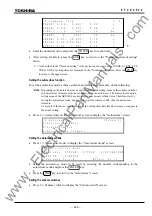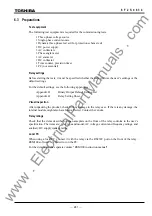
236
6
F
2
S
0
8
3
4
5. Installation
5.1 Receipt of Relays
When relays are received, carry out the acceptance inspection immediately. In particular, check
for damage during transportation, and if any is found, contact the vendor.
Check that the following accessories are attached.
•
3 pins for the monitoring jack, packed in a plastic bag.
•
An attachment kit required in rack-mounting, if ordered. (See Appendix F.)
1 large bracket with 5 round head screws, spring washers and washers (M4
×10)
1 small bracket with 3 countersunk head screws (M4
×6)
2 bars with 4 countersunk head screws (M3
×
8)
Always store the relays in a clean, dry environment.
5.2 Relay
Mounting
Either a rack or flush mounting relay is delivered as designated by the customer. The GRZ100
models are classified into two types by their case size, type A and type B. Appendix F shows the
case outlines.
If the customer requires a rack-mounting relay, support metal fittings necessary to mount it in the
19-inch rack are also supplied with the relay.
When to mount the relay in the rack, detach the original brackets fixed on both sides of the relay
and seals on the top and bottom of the relay. Attach the larger bracket and smaller bracket on the
left and right side of the relay respectively and the two bars on the top and bottom of the relay.
How to mount the attachment kit, see Appendix F.
Dimensions of the attachment kits EP-101 and EP-102 is also shown in Appendix F.
5.3 Electrostatic
Discharge
CAUTION
Do not take out any modules outside the relay case since electronic components on the modules
are very sensitive to electrostatic discharge. If it is absolutely essential to take the modules out of
the case, do not touch the electronic components and terminals with your bare hands.
Additionally, always put the module in a conductive anti-static bag when storing it.
5.4 Handling
Precautions
A person's normal movements can easily generate electrostatic potential of several thousand volts.
Discharge of these voltages into semiconductor devices when handling electronic circuits can
cause serious damage, which often may not be immediately apparent but the reliability of the
circuit will have been reduced.
The electronic circuits are completely safe from electrostatic discharge when housed in the case.
Do not expose them to risk of damage by withdrawing modules unnecessarily.
Each module incorporates the highest practicable protection for its semiconductor devices.
However, if it becomes necessary to withdraw a module, precautions should be taken to preserve
www
. ElectricalPartManuals
. com
Summary of Contents for GRZ100-211B
Page 323: ... 322 6 F 2 S 0 8 3 4 w w w E l e c t r i c a l P a r t M a n u a l s c o m ...
Page 343: ... 342 6 F 2 S 0 8 3 4 w w w E l e c t r i c a l P a r t M a n u a l s c o m ...
Page 383: ... 382 6 F 2 S 0 8 3 4 w w w E l e c t r i c a l P a r t M a n u a l s c o m ...
Page 395: ... 394 6 F 2 S 0 8 3 4 w w w E l e c t r i c a l P a r t M a n u a l s c o m ...
Page 411: ... 410 6 F 2 S 0 8 3 4 w w w E l e c t r i c a l P a r t M a n u a l s c o m ...
Page 423: ... 422 6 F 2 S 0 8 3 4 w w w E l e c t r i c a l P a r t M a n u a l s c o m ...
Page 443: ... 442 6 F 2 S 0 8 3 4 w w w E l e c t r i c a l P a r t M a n u a l s c o m ...
Page 451: ... 450 6 F 2 S 0 8 3 4 w w w E l e c t r i c a l P a r t M a n u a l s c o m ...
Page 459: ... 458 6 F 2 S 0 8 3 4 w w w E l e c t r i c a l P a r t M a n u a l s c o m ...
Page 463: ...w w w E l e c t r i c a l P a r t M a n u a l s c o m ...
















































